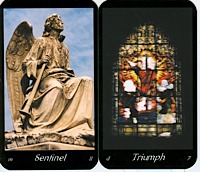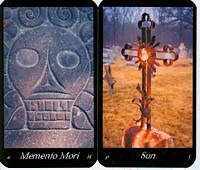By Sheri Harshberger
Graven Images Oracle, by Natalie Zaman and Katharine Clark
Published 2008 by Galde Press
Mention cemeteries and tombstones to people. In most cases, stereotypical horror movie images spring to mind -- it is always dark and gloomy, a thick mist or fog in the air and at the feet of the unwary victims, something scary lurking about the foreboding tombstones and crypts. Somehow, death and the dead were something to be afraid of.
Needless to say, I was expecting something creepy when I received the Graven Images Oracle. I really expected to find a very dark deck -- how could I not if all the cards were of tombstones and monuments and such? I was wrong. Could this have been done for creepiness? Yes, but it was not. In the Graven Images Oracle, Natalie Zaman and Katharine Clark have teamed to produce an oracle deck that is reverent and beautiful.
The 71-card deck is packaged with a beautiful black bag and a 110-page soft cover book that is roughly the size of a CD case. The packaging is minimal, which I really like, as storing the oversized kit boxes and even standard sized deck boxes can be problematic.
Each of the 71 cards displays a beautiful color image of a graven image (a monument, tombstone, statuary, or metalwork) framed in black, along with a card title, division, and number which are used in their unique system. Seventy of the cards are split into 5 divisions, each representing a point on a pentagram: Light, Physical, Mental, Social, and Emotional. There are 14 cards within each division. Seven of the 14 cards in each division represent the positive, higher aspects, or light, of the division, and the seven others represent the baser characteristics, or shadow aspect, of the division. The 70th card is Memento Mori (remember death), and if all the cards are laid out in a circle or progressive sequence according to the system, the meanings move from spirit to physical to beyond, ending with this card. The 71st card is called The Wall and has no division and no number (other than 0). The card backs feature an image of a tree engraved into granite... most likely a close up of an actual detail of a tombstone or memorial. The cards are not intended to be used with reversals.
The cards themselves have an ancient, homemade quality to them. Primarily, I believe this is due to the timelessness of the images on each card. Stone and metal have lives that far outlast our flesh. The angel statue shown on the Sentinel card could be 100 years old or far less. The same can be said for the cross shown on the Sun card. The ever so slightly uneven lengths of the cards also contributes to this feeling. The card stock is very flexible but somewhat difficult to shuffle due to the uneven lengths of the cards.
The companion book begins with introductions by both Natalie Zaman and Katharine Clark. There are sections on handling and cleansing the cards, sections that describe their system, and lastly, a section presenting several spreads that can be used with the cards, including suggestions on using these cards in spreads traditionally associated with Tarot cards. However, there are some things that bother me, and they are similar to the things that bother me about some of the text that accompanies the other decks, like the Russian Gypsy Fortune Telling Cards. There is an undertone to the sections on Handling the Cards and Cleansing the Cards that seems a bit superstitious to me, which normally wouldn't bother me except for the way it is presented... as hard and fast rules. Granted, what is talked about adds a mysterious flair to the oracle, and I am not dissing the creators for their beliefs, it just comes across a bit too superstitious for my tastes, such as the deck "should never be handled as regular playing cards because it's bad for the deck and bad for your reading." They specifically mention not to "build bridges" shuffling -- which is one of the reasons I think the cards are somewhat uneven. It makes it very difficult to fan or bridge shuffle the deck. There is also the description for The Wall card: "The reading has ended. All cards should be returned to the deck, cleansed, and the question/reading begun anew." But to each their own. That's what's great about being a reader, you get to do what you believe in and it works for you! I treat this oracle with reverence and respect, as I do all my decks and oracles, but I don't follow any of their "rules" about using the deck, and I still get fine results.
There is a lot to like about the system that is introduced with this oracle. It gives stunningly accurate results and it doesn't mince words. If you ask, it will tell you, even the stuff you don't want to know. I can also see other ways to use this oracle to fit my own reading style. I highly recommend this deck for anyone who is interested in exploring themselves or reading for others in a new and interesting way.



